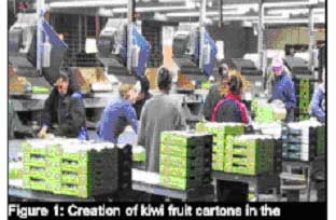
The Internet of Things “escorts” food safety
[ad_1]
From clenbuterol, “sterilized” cucumbers, “explosive” watermelons, to dyed steamed buns, baked bread, plasticizers… The recent food safety scandals have made people fearful. How to eat safely has become a topic that people have to pay attention to. At the China International Internet of Things Conference held a few days ago, experts at the meeting said that building a three-dimensional Internet of Things system not only traces the source of food, but also seamlessly perceives and monitors the food production process in real time to stifle food safety issues. In the cradle.
Supervise food safety “one hand”
At present, Ambient Systems has developed the third-generation RFID technology, which can not only monitor the bagging of items, but also locate these items. Once there is an abnormal situation such as a temperature change, it will issue a warning. In addition to the functions of dynamic tracking and event reporting, it can also manage the life of the cold chain shelf. If there is a sensor on the transport truck, it will also capture various parameters related to the freshness of the food. According to the freshness, judge whether to put it on the shelf or put it in the storage room first to avoid the loss of some fresh food.
RFID electronic tags are only part of the “Internet of Things”, and wireless waveguides and embedded processing functions are also important applications. Food safety should be an open platform, with various users to provide services, rather than producers themselves to build sensor networks and transmit food safety information. It is not the sales person telling you that the food is safe, but an independent information gathering party telling you that the food is safe.
Even in food tracking and monitoring, there is a lot of knowledge. Food will undergo various changes during transportation. It will rot due to changes in temperature or humidity, and will be damaged due to improper handling during transportation. Therefore, there must be temperature and humidity sensors and vibration sensors during the measurement process. There are acceleration sensors, etc., and sensors should be placed in the grain warehouse. Through the collection of information, it is not only used to ensure food safety, but also to do some secondary services, such as how to set prices, how to reduce food waste, how to improve logistics chain management, and so on.
“Clenbuterol” is directly blacklisted
In fact, some advanced Internet of Things technologies have been tested first in some non-staple food markets in Shanghai. From live pigs to be slaughtered to pork leaving the factory, every procedure uses chips to record detailed information; even at the consumer end, there is a unique “electronic ID card” for consumers to trace and inquire. After improving the traceability system, almost all pork sold in Shanghai will have its own “electronic ID card.”
During the slaughter process, each hook that hangs a pig has a chip the size of a dollar coin. The chip records the production and inspection data of the pig’s origin, inspection and quarantine, weight and fat grade, as well as important information such as who handles it; after the slaughter is completed, the pig will have a unique number. After the pork goes to the market, if a problem occurs, it can be quickly traced back to ensure safety based on this information. Even if the pig’s internal organs have been separated from the body, the source can be traced through a unified code. After the live pigs are sold, the information of the sales end such as large supermarkets and standardized vegetable farms will be recorded in the system in detail. Consumers can check online to learn about the origin of the purchased pork, farms and other information, so as to realize the full traceability.
Gu Zhenhua, director of the Food Inspection Division of the Shanghai Food and Drug Administration, said that the pork traceability system has covered 16 slaughterhouses and 8 large wholesale markets in Shanghai, realizing the whole process of monitoring “from the source to the table” and facilitating government supervision. The traceability of the breeding link has always existed before, but Shanghai has extended this traceability system from the breeding link to the consumer end, so that every piece of pork can be directly traced to the source. Once it is discovered that clenbuterol has been added to a farm outside of the country, it will be directly included in the “blacklist”, and the pigs of the farm will be prohibited from entering Shanghai and notified to the relevant local supervisory authority; if a local farm is found to have violated regulations, it will also be taken into account. Transfer to relevant departments for investigation and punishment. With the development of technology, the Internet of Things technology will be used more widely in the future, and it will play a key role in dealing with food safety issues.
[ad_2]




